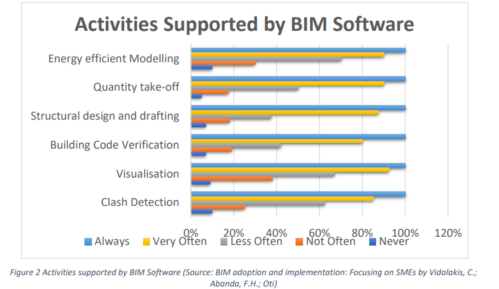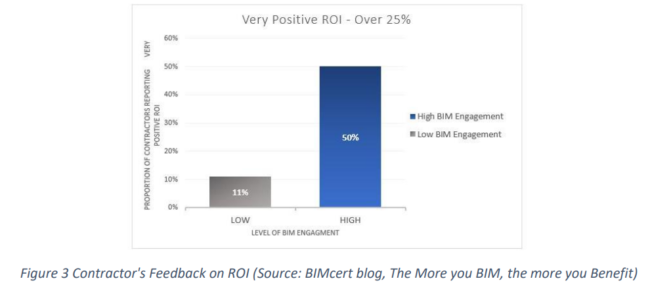BIM for Small to Medium-sized Construction Companies
How important is this BIM in context with smaller projects with
smaller budget? How seriously it should be taken? How does this
BIM adoption vary from small to medium-size enterprises and
what can be the benefits & Return on Investment?
Even though BIM is now talk of the industry & being widely discussed for its
contribution, there are still many confusions and uncertainties around how it can contribute to contractors immensely especially in context with Small to Medium Size GC’s. (SMGC) A few misconceptions around BIM adoption are:
- BIM is a fancy name for the 3D modelling
- The cost of BIM adoption does not justify ROI
- Smaller projects cannot take advantage of technology as the bigger ones
- There are only few ways one can utilize BIM
- Why replace traditional processes if they still work

While this article will clear some of these misconceptions it will also outline how SME’s can leverage BIM and the latest technologies to increase the productivity efficiency and profits on the project.
Contractors come into the picture after the designs stage. Following old-fashioned ways doesn’t let contractors have any part in the design process. BIM lets contractors take part in the design process which gives contractor’s better understanding & also makes them responsible for any exclusions or inclusions in the drawings (Morrissey, 2018). The key takeaway for the contractor from this is, they can see the asset virtually which gives them more understanding of problems that can arise during the post-design stage and they can be taken care of.
This collaborative approach between the designer and contractor allows them to see each other problems which helps the project in a great way than working individually. Following are the benefits that contractors can enjoy by implementing BIM:
1. Clear understanding between different stakeholders: From the BIM model contractors will be able to see a 3D representation of models which gives them a clear understanding in detail & how to implement it in order to achieve the end product in a more efficient way. (time & monetary wise). When phasing is used to its high potential high results are achieved in the projects. When the contractor contributes during the final stages of design by recording the site logistics information into the model which allows the designer to aid on the site. This provides the contractor to be fully prepared before the construction phase starts.
2. Resource Planning: All the activities like Material take-off, site logistic planning and cost planning come under this section. As BIM provides estimation directly from the 3D model there is no need of using 2D models and performing manual quantity takeoffs. By usage of BIM for estimation, contractors can get yield profits by proper costing of materials. When it is used to its maximum capacity for its material takeoff capability BIM gives contractor’s a clear-cut idea of costs that are going to occur and where they can be minimized even before the construction stage begins. The phasing of site logistics capabilities is one of the best tools BIM has to offer for construction contractors. BIM software has the capability to create detailed sequences for all activities even before the project goes to the construction stage, making it. much easier to understand how to handle construction. BIM also provides a safer working environment by identifying the potential hazards on the construction sites which provides a safe work plan for contractors to implement for workers’ safety. Implementing services like clash detection provide you with a very better opportunity to plan it right for once and all and avoid reworks which are time-saving and money-saving to the contractor.

Return on Investment (ROI):

Figure 3 Contractor’s Feedback on ROI (Source: BIMcert blog, The More you BIM, the more you Benefit)
BIM implementation enables teams to communicate and collaborate in an efficient way which automatically impacts productivity comparatively. It is a well-known fact that higher productivity results in more profits this can be one of the best ways to evaluate the ROI (Neelamkavil & Ahamed, 2012-02-01). In order to see the capacity of BIM, it should be implemented from start to end on a project. Fig.1 shows the feedback from the contractors about benefits from ROI implementation. The figure illustrates that the higher the contractors engage in BIM higher the profits. Even the low-level implementation of BIM yields benefits to contractors. (Source:
BIMcert blog, The More you BIM, the more you Benefit).
While the benefits coming out of BIM are evident there are some certain issues SMGC’s face when adopting new technologies:
Let’s identify these issues and suggest systematically appropriate solutions for those.
a) Financial issues: This is a major hurdle when it comes to small, medium enterprises. Due to very less industry methods that calculate ROI. Some of the financial challenges that SME’s face is high software fee, high licensing fee, high set-up cost, software interoperability issues etc.
Solution: This hurdle can be overcome by creating a proper BIM transition plan which contains researching all your choices which software suits best for the firm & efficient in terms of productivity& cost, defining a clear goal, deadlines & action plan. Lastly, stay with open arms for the firm’s transition from old traditional practices towards BIM.
b) Time investment: This is the next big hurdle that impacts BIM implementation in SMEs. Due to the limited resources, SME’s have they cannot afford extra heads on a project as a result time constraint is on their heads and they will be on a tight schedule to finish the allocated work inside the deadline, and they can’t invest time to explore more workflows.
Solution: This hurdle can be overcome by early planning from the whole team, creating a clear BIM transition plan & getting BIM support either external or internal.
c) Hiring a required BIM expertise: Unlike large enterprises, SMEs are not a go-to place for highly qualified BIM experts because of the reasons like less salary and career developments comparatively. Due to the lack of experts often SME fail to put a proper BIM working system. It is very vital for SMEs to get a clear understanding of who is going to be BIM managers.
Solution: This hurdle can be overcome by creating a better working environment for BIM expertise by revising the existing workflows along with roles & responsibilities like Scope definition, project & business alignment, project mentoring, BIM standard check, support from senior members of the team and hiring a BIM consultant.
However, there are some issues to be still resolved to make this BIM hassle-free for organizations to adopt and implement it:
Issues Unresolved:
1. Compatibility issues with Partners: Before implementing BIM as a contractor, one needs to make sure that everyone involved (partners or sub-contractors) is equally knowledgeable about BIM. If not, the gap starts here causing inconsistency in works or they may not at all be able to work on your models.
2. Organizational Issues:
i) Software issues: BIM software requires a substantial investment in new
technology. The advantages usually make the investment worthwhile, but
only if the software is used to its full capacity.
ii) Skillset: In an organization experienced people have experience of project delivery but don’t understand the nuances of BIM. When the organization hires new graduates with solid concepts of BIM even, they have no experience in project delivery when they are made team with experience people the mix can
3. Legal Issues: This is the major problem that a firm or a contractor can face while implementing BIM. This is where the responsibilities have to be clearly defined. And it has to be clearly mentioned who is responsible when the issues arise? Not just the designer to be blamed or made responsible for the issues or not one organization to be blamed unfairly. It has to be clearly mentioned in the contract about this clause which mitigates the legal risks.
4. Ownership issues: The main issue that arises is who is the sole owner of the model. As multiple stakeholders are involved, they hold ownership of their part of the contribution. Issues will arise when someone considers that they are the sole owners of the model this problem can be mitigated by clearly defining the ownerships in contract agreements.
Conclusion:
It is not a surprise now that BIM has a lot to offer than what everyone in the
industry thought a decade ago. One thing to remember is BIM has benefits to offer to everyone irrespective of the level of implementation. Alongside benefits, BIM also offers a handful of downsides to the contractors and construction industry. It is fair to say these are mainly human errors than tech errors. Lack of proper knowledge can be considered as the main cause for these downsides. Yes, BIM generates 3D models which can be very fancy for contractors who until now successfully delivered projects with a set of 2D drawings and construction documents. However, these days project owners are increasing including BIM scopes for the projects, and it only makes sense for contractors of any scale to not just adopt but also embrace BIM and other digital technologies in the construction process.
